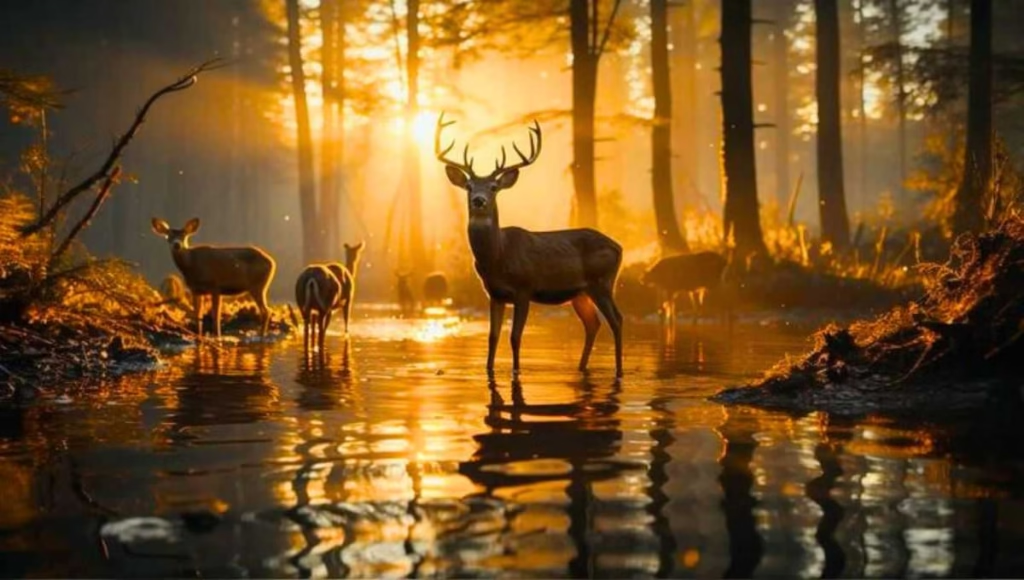Floating National Park: Imagine walking on a gently floating meadow on a tranquil lake – a land that moves, breathes, and holds life. Sounds unreal? Welcome to Keibul Lamjao National Park, located in Manipur, India, the world’s only floating national park.
Spread across 40 square kilometres on the southern edge of Loktak Lake, this ecological wonder is not only a symbol of India’s biodiversity but also a monument to how nature can adapt and thrive in extraordinary ways. The park is home to rare species, unique habitats, and a delicate ecosystem that literally floats on water.
In this article, we will explore the fascinating story behind this natural wonder – its unique floating properties, diverse wildlife, ecological significance, and why it has captured the world’s attention as one of the most unusual protected areas on Earth. Let’s dive into the discussion on the world’s only floating national park.
Where is the world’s only Floating National Park located?
Keibul Lamjao National Park is located in the Bishnupur district of the northeastern Indian state of Manipur. It is an integral part of Loktak Lake, the largest freshwater lake in the region.
What makes this park extraordinary is its foundation – a collection of phumdis, which are floating biomass made up of plants, soil, and organic matter. These phumdis create a spongy surface capable of supporting both animals and humans.
During the dry season, the phumdis touch the bottom of the lake, absorbing nutrients; during the rainy season, when the water level rises, they float again—a natural rhythm that has continued for centuries.
Keibul Lamjao’s unique floating ecosystem
Unlike traditional forests or wetlands, the ecosystem of Keibul Lamjao is dynamic and ever-changing. Its floating grasslands, shallow waters, and wetlands create a rare habitat that supports a variety of aquatic and terrestrial life.
Phumdi: The Floating Bastion
The Phumdi are the lifeline of the park. Some of these floating mats are thick enough to hold deer and even small trees. They cover about two-thirds of the lake’s surface, which constantly changes with the water currents.
These mats act as natural filters, improving water quality and providing food and shelter for countless organisms.
Wildlife in Keibul Lamjao: A haven for rare species
The Floating National Park is famous for being home to one of the world’s most endangered animals – the sangai, also known as the eyebrow-scaled deer or Cervus ldii ldii.
Sangai – The Dancing Deer of Manipur
The Sangai is often called the “dancing deer” because of its graceful gait while walking on soft, floating phumdis.
Once believed to be extinct, it was rediscovered in 1953 and is now listed as endangered by the IUCN.
It’s been 200-250 Sangai have lived exclusively in Keibul Lamjao, making it an important conservation area.
Birds and Aquatic Life
The park is also a paradise for bird lovers. It attracts migratory species such as:
- Eastern imperial eagle
- Black kite
- Blyth’s reed warbler
- Spot-billed duck
Fish species such as Channa striata (snakehead) and Labeo rohita (rohu) thrive in the lake’s nutrient-rich waters, supporting both wildlife and the local fishing community.
Cultural and Ecological Importance
For the people of Manipur, Loktak Lake and Keibul Lamjao are much more than natural wonders — they are lifelines.
Source of Livelihood
Thousands of locals depend on the lake for fishing, agriculture, and ecotourism. Floating huts called phumshangs are built on the phumdis, where families live and fish year-round.
Environmental Significance
Keibul Lamjao serves as a natural flood control system, absorbing excess rainwater during monsoons. It also maintains regional biodiversity by supporting rare plants, aquatic insects, and migratory birds.
Cultural Symbol
The Sangai deer is the state animal of Manipur and holds deep cultural value. It symbolizes the bond between humans and nature — fragile yet resilient.
Challenges Facing the Floating National Park
Despite its beauty, Keibul Lamjao faces severe ecological threats:
- Shrinking Phumdis: Due to hydropower dams and altered water levels, phumdis are thinning and losing buoyancy.
- Pollution: Industrial waste and agricultural runoff threaten the lake’s water quality.
- Encroachment: Expansion of floating settlements and unregulated tourism disturbs wildlife habitats.
- Climate Change: Unpredictable rainfall patterns affect the delicate balance between floating and grounded phumdis.
To combat these issues, the Manipur Forest Department and organizations like the Loktak Development Authority (LDA) have initiated restoration and awareness programs, aiming to preserve this one-of-a-kind ecosystem.
Tourism at Keibul Lamjao
If you ever plan a visit, Keibul Lamjao National Park offers one of the most surreal natural experiences in the world.
Best time to visit
November to March is ideal, when water levels are stable, and wildlife sightings are frequent.
Things to Do
- Take a boat safari across the floating meadows.
- Visit the Sangai Viewpoint for panoramic scenes of Loktak Lake.
- Explore nearby attractions like Sendra Island and the INA Memorial at Moirang.
Visitors often describe the sensation of walking on the park’s surface as “walking on water” — an unforgettable moment that blends wonder with awareness of nature’s fragility.
The Keibul Lamjao National Park is more than a global ecological wonder; it’s a living symbol of harmony between land, water, and life. As the world’s only Floating National Park, it teaches us how nature can innovate to sustain balance, beauty, and biodiversity
Protecting this floating paradise is crucial, not just for the Sangai deer, but for our planet’s ecological future.
Discover more nature stories and travel insights at indnexa.com, where conservation meets curiosity.
Hi readers. I’m Piyali Batabyal, a passionate blogger who loves to share her thoughts, ideas, and experiences across a variety of topics—from lifestyle and beauty to personal growth and creativity. With a curious mind and a love for words.
Alongside my writing, I am also a professional makeup artist with a flair for enhancing natural beauty and creating transformative looks.

